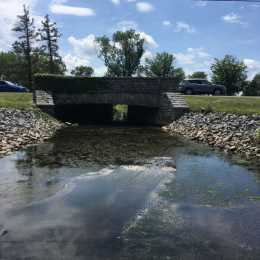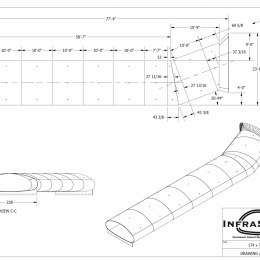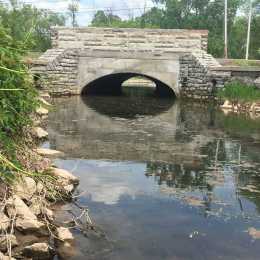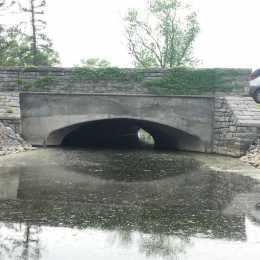Project Description
The Project
Precision Pipe and Products worked with DOT design engineers to provide a 234” X 72” X 1.00” Arched Reducer inlet, connecting to a 174” X 72” X 1.00” InfraSteel Arch liner, for the rehabilitation of a culvert at Onondaga Lake Park in Salina New York. The 77’-4” long culvert rehabilitation project was completed under heavily traveled Onondaga Lake Parkway in Upstate New York.
The indigenous Onondaga Nation, as well as other indigenous peoples, consider the Onondaga lake sacred (reading up on the fascinating history of the lake and people is highly recommended).
The residents of the Syracuse NY area have enjoyed the park, which is 7.5-mile linear greenway on the shores of Onondaga Lake, for years. The ends of the existing structure incorporate beautiful stone masonry, which was important to the project owners to preserve. The project owner also wanted to maintain the profile view of the structure barrel, which had been lengthened and changed during past road widening construction. In order to do this the design team faced the challenge of transitioning from a 234” diameter span at the inlet, to a 174” diameter span main barrel, while navigating a 20.44° bend.
The Challenge
InfraSteel spent 3 years working with the designer, and provided 18 revisions of drawings, to develop a functional and aesthetically pleasing design. A major emphasis was to provide a design that insured that the contractor would only be required to make square end field welds, and not be burdened with welding complicated angles.
The final drawings and liner wall thickness met the owner’s hydraulic requirements, as well as HL 93 load bearing requirements, with a 70-year life expectancy.
Tioga Construction of Herkimer, NY was the low bidder and were chosen to do the construction. Tioga had experience slip lining with InfraSteel liners in the past, so they knew what they were getting into from a constructibility standpoint. However, when working near Onondaga Lake there is always the prospect of running into contaminated soil. The abundance of salt brine and limestone in Onondaga Lake’s watershed area attributed to industrialization along the lake’s shoreline as far back as the mid 19th century, and for a period of time Onondaga Lake was one of the most polluted lakes in the United States. When Tioga began preparing the site for construction they ran into contaminated soil, and although there were provisions in the contract that addressed this possibility, it took several weeks to devise a plan for removal, and for the removal of the soil to take place. This process pushed the installation of the InfraSteel liner into the hard winter months of Upstate New York.
The Solution
Tioga dewatered the site and constructed a load bearing bottom in the existing structure. Since the water runs through the structure into the lake, it is an outlet-controlled culvert, so coffer dams were installed at both ends of the construction area in order to keep it dry. Bypass pumping from the inlet end was done using discharge hoses running through the barrel.
Tioga welded and pushed the liner segments into place. The work began at the outlet end by welding and pushing into place 6 of the 174” X 72” liner sections. The bevel configurations were designed so the welds on the bottom of the sections could be welded from inside the sections, to eliminating the need for welders having to get underneath them. The tops and sides were welded on the outside.
To manipulate the bend, a 174” X 72” X 4’-7 1/2”, 20.44° Elbow section was fed in from the inlet end. The Elbow, which was fabricated at the plant, was designed to be completely welded from inside of the liner where it adjoined the straight run that was fed from the outlet. The other end of the elbow was welded to the last 10’ section, that was pushed into place form the inlet end. These pieces were designed, fabricated, and installed with great care, to insure they would match up with the 57’ run, and align into the correct position within the existing structure.
InfraSteel engineers determined that welding the 234” X 72” reducing inlet piece, to a 20.44°mitered section, allowed parallel alignment of the inlet and outlet ends, and perpendicular alignment with the main barrel, without requiring an otherwise difficult mitered field weld. There were also structural design issues to overcome after load calculations showed that early reducer designs did not meet HL 93 loading requirements.
Additionally, both of the ends were shipped with Toe Plates that were tied into poured Cut-Off Walls. Grout was then pumped into the annular space through 2” grout ports that were manufactured into the liner and positioned along the tops and sides of the InfraSteel liner.
Tioga successfully completed the installation without traffic interruption, while maintaining the structures aesthetic qualities.





